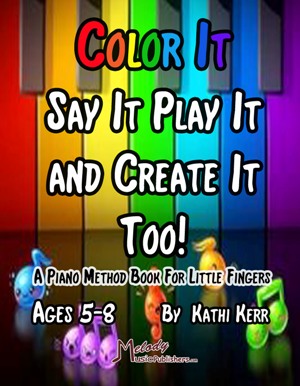Piano Method Books That Make Teaching Easy!
Hey fellow piano teachers, what if there were piano method books that made your teaching job so easy, you feel you’re hardly working at all? That’s exactly what the “Drill & Excel On the Piano” book series does! Click any book to watch a movie where the author goes through each page with commentary. Most piano method books are songs with little information included. This means you have to explain in detail every new concept. And since piano method books don’t include every part of the lesson needed, you have to supplement books for teaching exercises, scales, theory, note naming, and rhythm games to improve their reading ability. Having multiple books also makes it challenging in the lesson for both you and the student.
Everything in one book
At Melody Music Publishers, the “Drill & Excel On the Piano” series has everything in one book. Each book is in 3 chapters and includes multiple note reading and interval worksheets, rhythm drills, exercises, and special exercises for specific skills, scales, and 20 original songs per chapter (totaling 60 songs per book)! Since the author, Kathi Kerr, writes the songs, a student has to read the notes and not rely on their ear to play. Most method books brag about having songs students are familiar with. However, if reading music fluently is the goal, a student can trick the piano teacher when playing a song if they rely on their ear instead of reading the notes.
Easy Steps to follow
Teaching from the “Drill & Excel On the Piano” series is nice because it lays out the information in an easy to follow step format. Without a book to guide the teacher and student, it’s easy to forget about important steps the student needs. However, with these books, the piano teacher can relax and know each critical step is included, taught straightforwardly with examples, drills, and exercises. The repetition given ensures the student fully understands each step before moving on to the next one.
Written Worksheets
Why are writing assignments so important? I believe writing the information is the first layer of understanding and retaining the information. When a student repeatedly writes the names of the notes or intervals, they’re more likely to retain the information. With the “Drill & Excel On the Piano” books, there are multiple worksheets to help students learn and remember notes. No acronyms are taught, like “Every Good Boy Does Fine.” Instead, the staff’s logic is shown, and five sets of notes are taught at a time with multiple worksheets per set of notes.
Rhythm Drills
Where’s the rhythm in most method books? Most piano method books may give the value of each kind of note, but nothing else. I have found rhythm is the most neglected part of piano method books and lessons. A student needs more than just shown each note’s value. To read rhythm fluently requires playing multiple rhythm drills. In “Drill & Excel On The PIano,” the note’s value is taught with multiple rhythm drills for the student to play. Playing them with a steady beat, and counting the beats out loud is recommended.
Exercises
As mentioned earlier, most piano instructors will use a separate book for exercises. However, many exercise books are not suitable for the beginning student when the pattern includes more than a five-note hand position. In “Drill & Excel On the Piano” books, the exercises correspond with the chapter’s songs and skills needed. For example, in chapter 1 of book 1, only five-note pattern exercises are given that go with the songs. As the hand position expands, the exercises do as well. There are also “special” exercises that go along with the skills needed for the songs. In book 1, chapter 3, an exercise to teach the skill of independence of hands is given. This helps when playing the songs with one hand louder than the other, and one playing staccato while another playing legato. A student first learns the skill in the exercise before applying it to a song.
Scales
Another supplemental book piano teachers often use is scales. In “Drill & Excel On the Piano,” each chapter has one key signature (except the recap chapters), and all the songs, exercises, and scales will be in that key. This makes everything they’re learning correspond to each other and creates a clear path for learning. Also, most scale books show the scale by notation. Playing scales by reading the notes may not help the student remember what sharps or flats are in each scale and key signature, or even understand them. In the “Drill & Excel On the Piano” series, the student plays scales by knowing what’s in each key signature. This helps the student have better retention and understanding of the scales, which is the foundation for learning music theory.
Intervals
Intervals are taught beginning in book 2, chapter 3. The emphasis in book 1 and book 2, chapters 1 and 2, are reading fluently and exercises to acquire the skill of playing. Chapter 3 of book 2 starts by showing the staff’s intervals in the key of C (C/D, C/E, C/F, C/G, etc.), with the interval number beneath. However, it doesn’t stop with merely explaining intervals. There are multiple worksheets for the student to identify the interval number without counting. Once a student can identify the interval at sight, this helps in sight-reading. Without repetitive written assignments, most students are not able to identify them at sight.
Songs, songs, and more songs!
And finally, the best part of “Drill & Excel On the Piano” are all the beautiful songs written by author Kathi Kerr. As mentioned earlier, the songs correspond with the chapter’s key signature. Written melodically, a student will find themselves singing the songs apart from playing them on the piano. Starting from book 2, each piece is in a different style with a commentary written by the composer. And best of all, they’re fun to play!
Each book recaps the previous books
Whatever the student’s level, he or she can start with any book in this series, since from book 2, the first chapter is a recap of the previous books—this way, no critical steps, and information are missing. For a beginning student ages 8-adult, book 1 is recommended. If a student has played a little piano, they can start with book 2 that begins chapter 1 with hands together. This book is also great for a self-taught student that plays well but may have missing information or someone taught incorrectly. Book 3 is excellent for the early intermediate student. And finally, book 4 is for the late intermediate student. There are more exercises, special exercises, rhythm drills, and lots of theory worksheets in books 3 and 4. “Drill & Excel On the Piano Book 5” is set to come out in late 2021 for the advanced student.
My first experience with this piano method book
When I had finished book 1, I used it on the students I was teaching at the time (I called them my guinea pigs). One of my students in particular had struggled in reading. However, when he started playing the multiple songs in each position, he was so accomplished at reading, he began sight-reading the songs nearly perfectly by the end of the chapter! I remember feeling so at ease and thinking “The book is doing all the work!” It was so much fun to see him go from struggling to sight-reading!
Order today and enjoy teaching
Order your copy of “Drill & Excel On the Piano” to relax and have a great time teaching your students, knowing they’re getting all the essential steps. Using drills and repetition, your students will have a deep understanding of all concepts and play the piano like a pro. It’s exciting to see the students’ progress and growth. If you’re a piano teacher who hasn’t registered, click here to sign up to receive discount codes for free shipping and 50% off your first copy, then free shipping and 20% off all recurring orders! Thank you for your passion and dedication to teaching private piano. We welcome your comments and suggestions to this post.

Kathi Kerr founded Melody Music Studios in 1989, a nationwide music instruction studio. In 2017, she founded an independent publishing company called Melody Music Publishers. They offer piano and singing method books using small steps and repetition, how students think and learn.
Piano Method Books That Make Teaching Easy! Read More »



